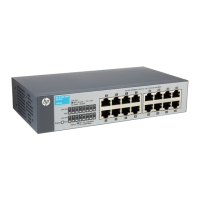15
Step Command Remarks
2. Enter interface view.
interface
interface-type
interface-number
Enter the interface for sending
NTP multicast message.
3. Configure the device to
operate in multicast server
mode.
• Configure the device to
operate in multicast server
mode:
ntp-service
multicast-server
[ ip-address ]
[ authentication-keyid
keyid | ttl ttl-number |
version number ] *
• Configure the device to
operate in multicast server
mode:
ntp-service ipv6
multicast-server
ipv6-multicast-address
[ authentication-keyid
keyid | ttl ttl-number ] *
By default, the device does not
operate in multicast server mode.
After you execute the command,
the device receives NTP multicast
messages from the specified
interface.
Configuring access control rights
Step Command Remarks
1. Enter system view.
system-view
N/A
2. Configure the NTP service
access control right for a
peer device to access the
local device.
• Configure the NTP service
access control right for a
peer device to access the
local device
ntp-service access { peer |
query | server |
synchronization }
acl-number
• Configure the IPv6 NTP
service access control right
for a peer device to access
the local device
ntp-service ipv6 { peer |
query | server |
synchronization } acl
acl-number
By default, the NTP service
access control right for a peer
device to access the local device
is peer.
Before you configure the NTP service access control right to the local device, create and configure
an ACL associated with the access control right. For more information about ACL, see ACL and QoS
Configuration Guide.
Configuring NTP authentication
This section provides instructions for configuring NTP authentication.
Configuring NTP authentication in client/server mode
When you configure NTP authentication in client/server mode:
• Enable NTP authentication.

